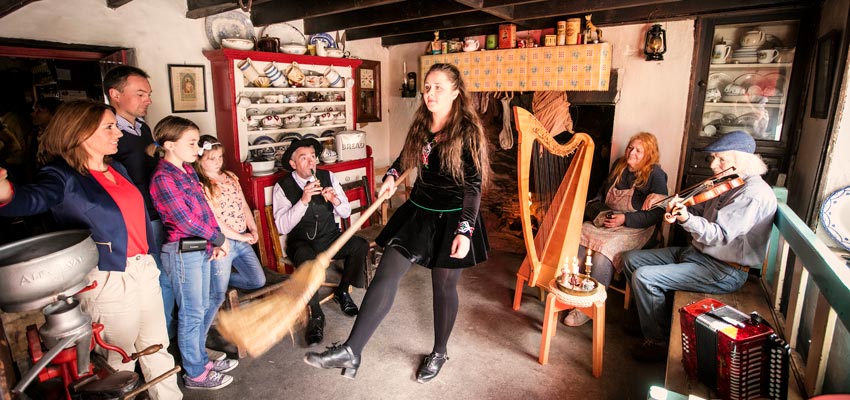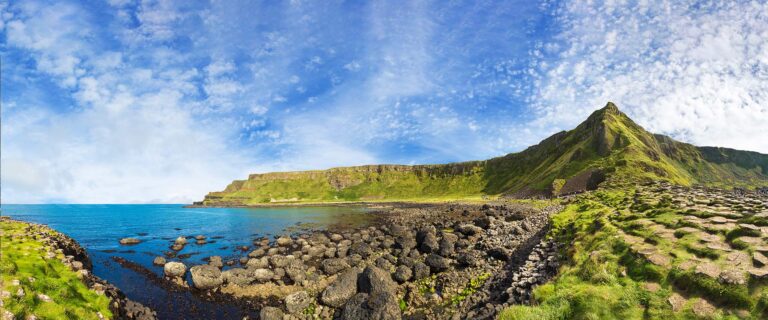Irish culture is rich, diverse, and a joy to discover. It includes myths, literature, music, dance, art, cuisine, and language. Originally the culture was purely Gaelic, but then it was influenced by the English, Tudor English, Scots, Normans, and Vikings. Northern Ireland’s culture was heavily influenced by the Scots. But, at its core, Irish culture has taken these elements and folded them into her strong, Gaelic heart.
Folk Tales and Myths
Fionn mac Cumhaill, or Finn MacCool, is the hero of the Fenian Cycle stories. He was a mythical hunter and warrior who built the Giant’s Causeway so he could walk to Scotland. Once there, he bested an ugly Scottish Giant, picked up part of Ireland, and flung it at him. That is how the Isle of Man was created. Other fantastic beings include Brian Boru as well as the Irish princess, Iseult, part of the Arthurian legends.
Leprechauns… we know about them. They’re little people who play tricks, make shoes, love money, and each has a pot of gold stashed at the end of a rainbow. Lady Gregory collected ancient Irish stories, and William Butler Yeats, taken with Irish literature, wrote the forwards. They were particularly taken with tales of Celtic women because of their power and tribal status.
When the Irish and Scots came to America, so did Halloween. It has its roots in the Gaelic festival called Samhain. During this autumn time, people felt the veil between this world and the one beyond was quite thin, making it possible for the dead to visit the living. Children dressed in costumes, asking for money or food, turnips were hollowed out, and faces were carved on them for lanterns.
Literature
After Greek and Latin, Irish is the oldest language in Europe—Ireland’s first poems were written in the 6th century. The country is small, but it is mighty—think of Bram Stoker, James Joyce, William Butler Yeats, and Oscar Wilde. Four Nobel Prize winners are Irish, including Yeats, George Bernard Shaw, Samuel Beckett, and Seamus Heaney.
From busy corners in vibrant Dublin to small cottage towns, Ireland has a wealth of storytellers. When visiting, consider attending a storytelling event in a local pub. You will be spellbound.
Music
There is nothing like traditional Irish music and the country’s pub culture. It is a family affair, a community affair, and you are invited to join the party. Music festivals abound, and though there was a shift from Irish music in the 1960’s to American and British rock and roll, Ireland did what it has always done when faced with outside influences. It folded the new in with the traditional. Rockers such as Van Morrison and U2 are pure Irish, and they draw from their Celtic Roots.
Dance
Irish Dance swept America with Riverdance, and Irish stepdancing classes took off. The costumes have embroidered patterns with designs taken from the Book of Kells. Originally from English country dancing and French quadrilles, dance was taught by dance masters who traveled throughout Ireland in the 17th and 18th century. Dance grew until it became important in Irish culture and in nationalist movements.
The music drives the dance, making it feel like a dervish, and shoes pound out the rhythm. In stepdancing, the dancer’s body is straight and stiff, and it is performed high on the balls of the feet. Very athletic! Irish dancers today, particularly women, make graceful, flowing movements with their arms.
Art
We first see Irish art at Newgrange, older than the great pyramids at Giza. In the Bronze Age, 3300 – 1200 BC, ornamental gold Celtic brooches give us a peek into a civilization long gone. The Book of Kells, an illuminated manuscript kept at Trinity College, was created around 800 AD. The lettering is in iron gall ink and some colors were imported from exotic locales. Christian symbols are interspersed with mythological beasts and complex Celtic knots.
Celtic knots are often seen in Irish art, both ancient and present. These images have no beginning and no end, representing the eternal nature of loyalty, friendship, and faith. Now often displayed in jewelry, they are inscribed on ancient tombstones throughout the country. Irish artists today are at the cutting edge, combining the feel of a lush countryside and turbulent history in their work.
Cuisine
In the Fenian trilogy we read about the Salmon of Knowledge, a wise man who once shape-shifted into a salmon. As in many cultures, honey was valued and used for making mead. We see this from Ireland to France to India. In 1589, Sir Walter Raleigh brought potato farming to Ireland. Before then, wheat, oats, barley, and flatbread were Irish staples. With its fine fields for cattle, dairy and beef have been mainstays for eons.
Today, traditional dishes, such as stews and colcannon, are being reinvented by world-renowned chefs. These chefs have also created new Irish cuisine, using only locally sourced fish, shellfish, vegetables, herbs, seaweed, and beef. Cooking schools, from Dublin to country farmhouses, are experiencing a renaissance.
Language
Ireland’s Gaelic language, Gaelige, is in the group of Celtic languages, and it is one of the oldest written languages we’re aware of. We first see it inscribed in the 4th century AD, and it ranged from all of Ireland to the west coast of Great Britain. It continued to be the Irish people’s first language until the late 18th century. There are still rural pockets in western Ireland where Irish is spoken as a first language.
A growing number of people in Dublin are learning and speaking Irish. Knowing the language has become a matter of pride, and it’s often taught in schools. In 2016, Duolingo reported that there is a burgeoning interest in learning Irish, worldwide.
Because Ireland was somewhat isolated, when customs came to her from other cultures—such as playing the bagpipes, dancing jigs, brewing stout, and even speaking a Celtic language—it remained on the island long after it died out in Europe. A visit to Ireland is a step into the distant past and an experience of the vibrant present. And all is revealed through her culture.
Ireland’s culture is rich, and it is easy to access. Ask your Destination Expert which authentic experiences will give you the best of what makes Ireland unique!
















